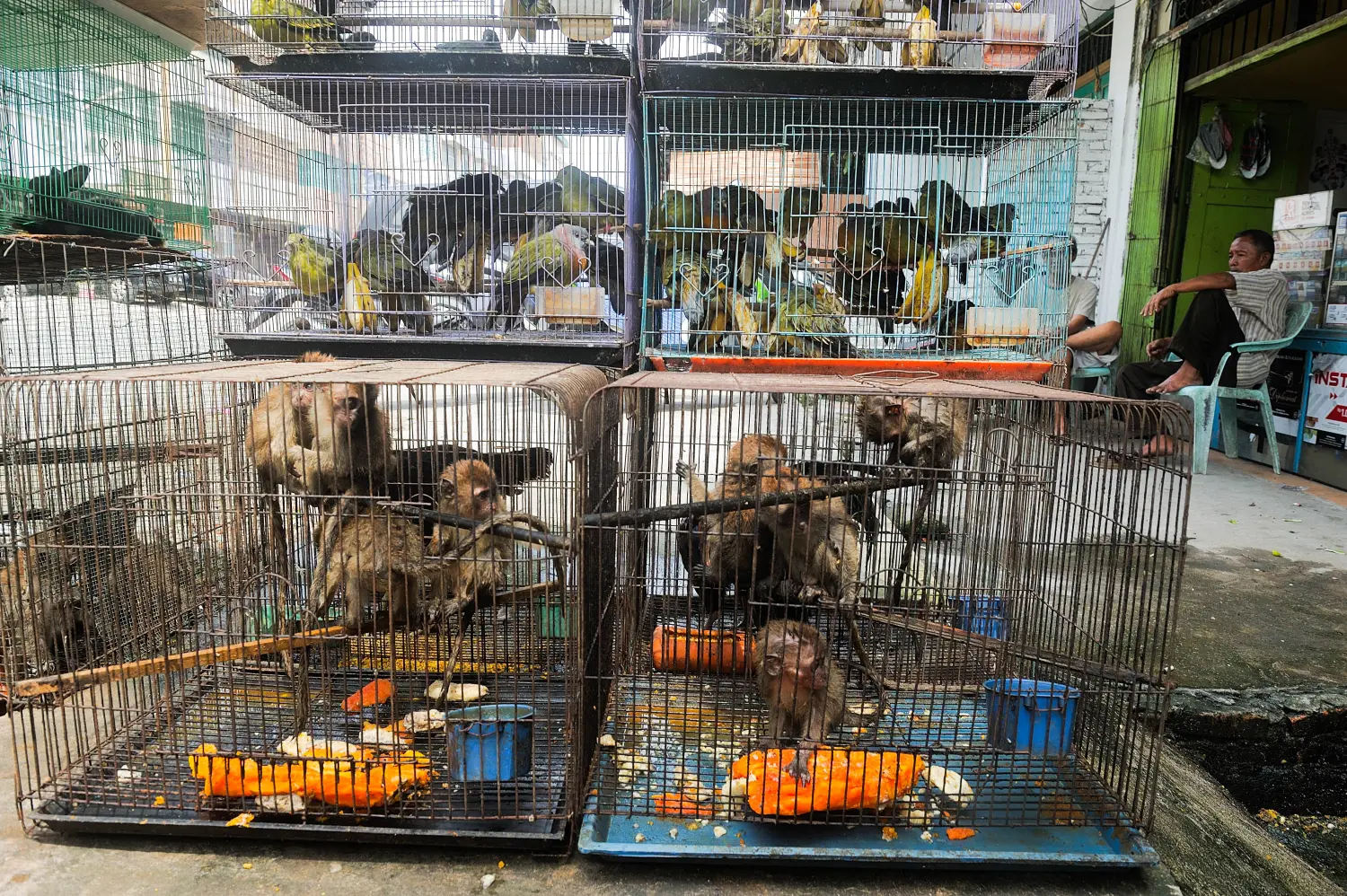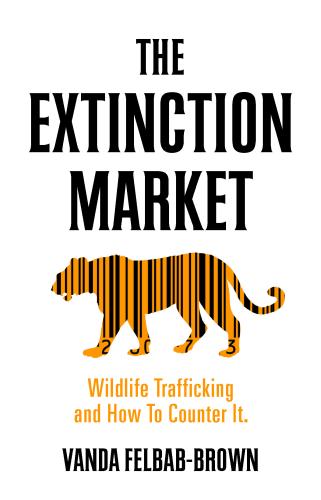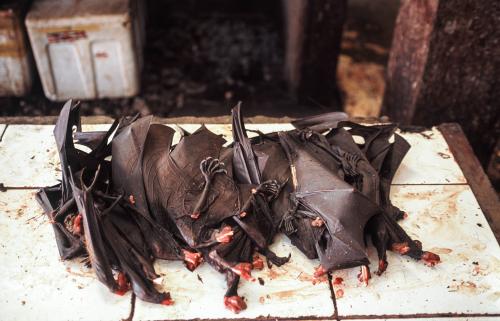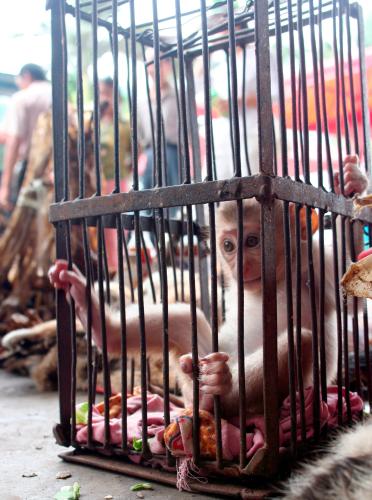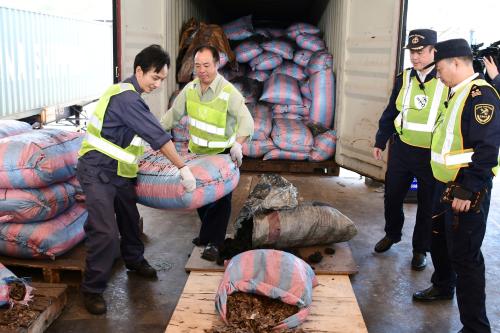This brief is part of the Brookings Blueprints for American Renewal & Prosperity project.
The global public health and economic devastation caused by the coronavirus (COVID-19) outbreak dramatically reinforces the urgent imperative to minimize the chances of another zoonotic pandemic. Reducing the likelihood of another viral spillover sweeping the world requires a fundamental change in how we interact with nature. It requires minimizing human interface with wild animals and wild spaces; eliminating transmission points where the likelihood of viral spillover to humans is high, such as unhygienic commercial markets in wild animal meat and live animals; better monitoring of the legal trade in wildlife; diligently suppressing illegal and unsustainable trade in wildlife; and conserving natural habitats. Conserving natural habitats in turn requires profound changes in human food production and human encroachment on remaining natural habitats. Decisionmaking about pandemic prevention and nature conservation must be elevated to the highest levels of governments on a permanent basis. Such changes will not be easy or cheap, but they are necessary.
Reducing the likelihood of another viral spillover sweeping the world requires a fundamental change in how we interact with nature.
However, the necessary measures to prevent another pandemic should not entail banning all trade in wildlife. Such a policy would be deeply counterproductive since it would eliminate economic incentives for preserving critical natural ecosystems. Nor should the measures involve eliminating livelihoods of the hundreds of millions of people dependent on hunting for basic food security and subsistence.
In order to preserve habitats and wildlife and keep them wild and away from humans to minimize zoogenic viral spillover, global demand for some wildlife products, not just wild meat, but also aspects of Traditional Chinese Medicine (TCM), also needs to be reduced.
Adopting such smart, tailored, and essential pandemic prevention measures is crucial for policy effectiveness. Critically, they need to be anchored in fundamental global efforts to save natural habitats and biodiversity.
Policies based principally on defensive reactive responses, such as strengthening health care systems or reshaping global production and logistical chains, are inadequate and will be overwhelmed. Yet those have been the bulk of policies around the world so far. With few exceptions, many of the disastrous policies that accelerate the arrival of another zoonotic epidemic or pandemic have accelerated during the COVID-19 period. What is needed is deep prevention based on a fundamental restructuring of how we treat nature, even after COVID-19 vaccines become widely available.
Challenge
As of January 20, COVID-19 has claimed over two million lives globally and infected almost 96 million people. Twenty years of poverty reduction efforts have been wiped out, with as many as 150 million people pushed into extreme poverty. Since many have been forced to liquidate their human development assets, they and their children may not be able to economically recover for years or decades. Many have been pushed into participation in illegal economies and thrust into the hands of criminal actors and militants. The cumulative devastation surpasses the scale of destruction many a regional war could inflict.
Even prior to the COVID-19 outbreak, zoonotic diseases (including HIV/AIDS, Ebola, SARS, flu, yellow fever, and others) caused millions of human deaths and a billion cases of human illness per year.
The emergence of other zoonotic diseases and devastating global pandemics is inevitable unless we fundamentally revise our relationship with nature. 75% of emerging diseases are zoonotic, the majority originating in wildlife.
The COVID-19 pandemic exploded in a so-called wet market in Wuhan, China, and entailed the meat of wild animals used for human consumption. Across East and Southeast Asia, open air markets of wild animals often illegally caught are kept in appalling and dangerously unhygienic conditions. Such markets selling wild animal meat and live animals without proper hygienic and veterinary measures pose very high risks of disease emergence and spread. They are present in other parts of the world, including Latin America’s Amazonia region and West and Central Africa. Some sell wild meat for basic subsistence, others are highly commercialized and sell wild animal meat as a luxury. The load of zoonotic viruses intensifies along the trade route from forest or farm to the unhygienic markets. Unlike in East Asia, the consumption of wild animal meat is uncommon in the United States. Nonetheless, bushmeat, sought out by diaspora communities, is smuggled to the U.S.
Zoonotic epidemics also emerge due to improper husbandry of domestic or wild animals and other veterinary failures. Such regulatory deficiencies are pervasive around the world and persist also in the United States. The H1N1 swine flu that killed 10,000 Americans emerged in North America as a result of packing thousands of domestic livestock together in a cramped space for food production.
Without adequate veterinary practices and pathogen monitoring, the trade in live animals — whether legal or illegal — is yet another spreader of infectious diseases. Between 2012 and 2016, over 11 million live animals representing 1,316 species were exported from 189 countries. China is the largest exporter. The United States is the largest importer of live mammals and amphibians for exotic pets. Yet even with all of the United States’ capacities and border security focus, only a very small fraction of animals legally crossing U.S. borders are inspected for diseases. This lack of health inspection poses grave risks to human health, native biodiversity, and local economies. For example, legally imported frogs carried the devastating chytrid fungus, putting all North American amphibians at risk. Monkeypox which infected people was introduced to the U.S. through such uninspected legal trade. Such dangerous absence of pathogen monitoring of the legal trade in wild animals and their meat, and of seized trafficked animals, is pervasive globally.
But it is human encroachment on natural habitats that poses the gravest threat of zoonosis, accounting for 30% of its emergence. As habitat is fragmented or lost, more animals crowd together in constricted spaces where the chance of a viral spillover between species significantly increases. When people and their domesticated animals enter such places —for logging, mining, hunting, food production, or road and residence construction — the odds of transmission to humans increase. Destruction of tropical forests is particularly rife with zoonosis. But zoonotic diseases could also break out in the Arctic and Antarctic regions where global-warming-induced melting of the permafrost can release dangerous pathogens.
Limits of historic and existing policies
Despite the severity of COVID-19 and the urgency of a radically new relationship with nature, smarter legal wildlife trade, and suppression of poaching and wildlife trafficking, most COVID-19 measures globally have centered on mitigation, through vaccine development or economic stimulus packages.
China, the world’s largest consumer of wildlife for meat and TCM, has adopted the most significant regulatory change: In response to COVID-19, it declared a ban on consumption of wild meat. China also shut down some wildlife markets and some of its 20,000 wildlife farms, an industry worth some $18 billion annually and employing 6.3 million people. The result is a near comprehensive ban on breeding, selling, and consuming terrestrial wild animals as food. Unlike after SARS, when such similar efforts faded within three years, the existing changes are to be permanent. But they also need to be diligently enforced, often a struggle in China. For example, although the use of pangolin scales is now banned from the official list of TCM ingredients, Chinese TCM companies still market them and China’s national health insurance covers such “medicine.” China also revised its Wildlife Protection Law, which, despite its name, had long enabled commercial trade even in some endangered species.
Still, more needs to be done.
First, if the ban on unhygienic commercial wildlife and wildlife meat markets remains confined to China, the risks of pathogen transmission will remain high elsewhere in Asia — particularly Indonesia, Laos, Myanmar, and Vietnam. If China’s and Southeast Asia’s demand is slashed, buyers of wild animals and their meat will merely outsource pathogen transmission to poorer countries even less prepared for zoonotic outbreaks. Chinese traders can simply arrange the poaching of pangolins in Africa (as is happening already) — not just for scales, but for their meat, and have it frozen. The viral spillover from this most heavily trafficked mammal, a known host to coronaviruses, would then occur among poor hunters abroad while Asian traders and consumers would not see their profits and habits affected.
Second, the new Chinese regulations have ambiguities and allow exceptions, such as the farming of wild animals for other commercial purposes like TCM (including the pathogen-rife large-scale production of bat feces to treat eye ailments) and the marketing of products from endangered species (such as products made from leopard bone). Although most TCM does not use wild animal parts, the products that do have dramatically exacerbated the collapse of wild species around the world through legal trade or poaching.
Critically, unhygienic practices on TCM wildlife farms produce similar risks of zoonosis, unless the veterinary and butchering practices are improved. Worse yet, many wildlife farms in China and elsewhere are, in fact, stocked from the wild, introducing pathogens to farms and jeopardizing wild populations.
Moreover, China has surrounded these policies with an aggressive promotion of unsubstantiated theories and falsehoods about COVID-19 having emerged outside of China, a narrative that raises questions about China’s determination to reduce the zoonosis-prone practices in China. Beijing also seeks to tightly control a World Health Organization (WHO) investigation into the COVID-19 jump to humans, designating Chinese scientists vulnerable to China’s pressure to lead key parts of the investigation. Nor has China mounted significant pressure on other countries to eliminate their urban wildlife markets.
In the United States, a new bill — the Preventing Future Pandemics Act of 2020 — calls for banning the import, export, and sale of live wildlife for human consumption. It would also make it U.S. policy to facilitate international cooperation to support wildlife market closures abroad by reducing demand for wild animal meat, shifting to alternative sources of protein, and improving monitoring of zoonotic diseases.
Yet U.S. policy to prevent the spread of zoonotic diseases remains fragmented and inadequate: With few exceptions, there are no U.S. laws specifically requiring disease surveillance for imported wildlife. Few U.S. — or international — agencies focus on zoonosis surveillance. Coordination among them remains insufficient. The Center for Disease Control and Prevention regulates only the importation of wildlife known to present “a significant public health concern,” but does not mandate pro-active pathogen monitoring of other species.
The European Union has proposed an international treaty on pandemics. Language circulated so far, and reflected, for example, in the G-20 Riyadh Summit Leaders’ Declaration, calls for both economic and social mitigation measures and prevention measures, including biodiversity conservation.
Yet poaching for international supply and bushmeat hunting for subsistence have intensified during 2020. The pandemic has dried up vital ecotourism funding for local communities, rangers, landowners, and protected-area administration, a $29 billion industry employing 3.6 million people in Africa. By July 2020, 90% of African tour operators had experienced a 75% or more decline in bookings, unable to support guards, guides, other employees, and operations. Most national park government agencies in East and Southern Africa are reporting 70 to 90% declines in revenue. Yet in South Africa, 85% of funding for protected areas comes from ecotourism and trophy hunting, mostly from foreign tourists. The presence of tourists and guides also helps surveillance and deterrence against poaching. Pressures to convert land from native habitats to agriculture are also rising.
Elsewhere, ecotourism has never brought sustained and sufficient funding to make biodiversity preservation viable, and many protected areas critically lack funding, and exist as “paper parks,” even as Africa’s population continues to expand and pressures on native habitats rise dramatically. The situation is similarly dire in many protected areas in Latin America and Asia.
Deforestation in tropical forests that are most valuable for zoonosis prevention, biodiversity preservation, and carbon sequestration has also dramatically accelerated during 2020. Budget-starved governments are susceptible to entreaties by powerful extractive industries promising rapid revenues from logging, mining, and agricultural production. Unemployed people have been desperately seeking jobs in illegal logging, mining, and poaching, especially as COVID-19 has produced reverse migration from urban spaces to rural ones for the first time in decades.
In Brazil, deforestation of the Amazon shot up to a 12-year high, with 4,281 square miles of rainforest destroyed from August 2019 to July 2020. Over 2,500 fires have raged there this year, indicative of land grabbers converting forests to pasture and croplands. Some burned deep inside the rainforest, advancing the Amazon’s irreversible tipping point of collapse. President Jair Bolsonaro’s policies to dismantle protections and enforcement have not changed significantly, even though a pandemic could easily emerge from Brazil and elsewhere in Latin America.
Even though in September 2020 the Green Climate Fund questionably awarded Indonesia a $103.8 billion payment for preventing deforestation and carbon release between 2014 and 2016, intense deforestation and fires took place then, and persist now. In the first weeks of 2020, forest loss in Indonesia rose by 50%. The deforestation fires pollute air with dangerous PM2.5 particles, further weakening human (and animal) respiratory systems and augmenting COVID-19 death rates. Worse yet, in September 2020, the Indonesian government introduced a bill to significantly weaken environmental regulations.
This immediate pandemic-producing environmental destruction is taking place as our planet is experiencing alarming levels of species loss. The rate of species extinction is now as much as 1,000 times the historical average, the worst since the dinosaurs died.
Policy recommendations
Dealing with pandemics cannot rest merely on mitigation. It must focus on deep prevention and synchronization with other policy objectives such as halting global warming. It must address all sources and vectors of zoonoses: legal trade in wildlife, poaching and wildlife trafficking, and habitat destruction.
Many of the action-points proposed below are resource-intensive. Implementing some will require international assistance to poor countries lacking capacities for implementation. Some will be politically unpopular: Both legal extractive industries and illegal economies often powerful lobbies to prevent, hijack, and subvert regulatory agendas. Poor regulation and illicit economies thrive in the context of corruption, particularly when it pervades the highest levels of governments. Prevailing over vested interests and corruption requires sustained domestic and international pressure. But at stake are tens of millions of lives and tens of trillions of dollars that no government should want to lose.
Implementation of the steps below will not take place overnight. It will be a gradual process of policies being changed, regulatory and enforcement systems being strengthened, and habits and practices being altered. Nonetheless, even a gradual adoption that does not achieve full compliance would reduce the speed and frequency with which zoonotic diseases emerge and flare up into pandemics.
Phasing out unhygienic markets in wild animal meat and live animals
Phasing out unhygienic urban markets in wild meat and live animals is imperative. In places where they are not the source of basic subsistence and protein access, such as in large parts of Southeast Asia, bans should be adopted. Such bans need to be diligently enforced even though it will affect the livelihoods of traders. Poor traders should be compensated for their losses.
When governments give permission to sell sale animals in stores or other venues, the licensing and inspection processes need to ensure that proper care and hygienic conditions are maintained. Violators need to have their licenses removed and face meaningful prosecution.
Wet markets in China and Asia should not be banned. Most do not sell meat from terrestrial wild animals. They provide access to food for many people in Asia, sometimes as much as 30-40% of the population. However, like in wildlife-sale venues, diligent monitoring and enforcement need to be implemented, such as through the use of CCTV cameras.
Where wildlife meat markets serve as sources of basic subsistence, such as in West and Central Africa, they cannot merely be banned. Hundreds of millions of people around the world depend on hunting for protein access. A ban on wild meat should not undermine their food security. Phasing them out will take time and needs to be accompanied by working with local communities, understanding drivers of wild meat consumption, overcoming obstacles to the development of alternative sources of protein development and consumption, and developing other sources of income.
Such efforts will also require changing preferences in taste and habits of wild meat consumption. The consequences of zoonotic pandemics in terms of global deaths and poverty, which ultimately hurt local subsistence communities, are too large to merely accept that people have a cultural preference for wild meat. Just as affluent consumers in Asia need to accept changes for global public safety, so do people in Africa, though no one can be left to starve. (People may have a taste for driving fast, yet the world has adopted speeding regulations). Moreover, bushmeat hunting is often not sustainable and contributes to biodiversity losses and food and economic insecurity, such as in Ghana.
Where alternative protein sources cannot be developed, and even where they can, resources for pathogen testing in meat (also fruit, a link in the Ebola outbreaks) need to be made available to local communities. International assistance should also focus on bringing refrigeration, health inspections, and hygienic slaughtering practices to local communities. Efforts to wean marginalized poor communities off wild meat need to be accompanied by broader development efforts, including health and schooling, and the delivery of environmentally-sustainable economic opportunities.
Enforcement of bans
Diligent efforts are required to enforce such bans, anticipating that they will push trade in wild animals and meat underground or online. Illegal warehouses of wild animals and meat can be dangerous sources of zoonoses and must be shut down, their operators prosecuted. Enforcement poses challenges, as smuggling networks will seek new routes and markets, as happened after the EU’s ban on wild bird imports after the avian influenza outbreak. Law enforcement forces can respond by mounting extensive undercover operators online and on the ground.
Not all illegal markets are equally dangerous: Any time significant barriers to entry are put up for a market, such as through bans and enforcement, demand goes down — as some buyers will not invest in seeking out hidden online platforms or locating an underground market, and risking penalties. No doubt there are risks that even smaller illegal markets will be a source of transmission if pathogen monitoring is not possible.
It is imperative to achieve substantial effective identification and prosecution of violators to create deterrence effects against clandestine offenses. Such a robust prosecution rate requires resources for what are not current law enforcement priorities and capacities. Equally needed is testing for all seized meat and animals for pathogens, and their safe handling.
But if a ban pushes a market underground without any enforcement and pathogen monitoring, and demand has not gone significantly down, as would likely happen in wild meat subsistence markets, the policy outcome can be worse than the original problem. Sequencing, preparation, and local tailoring matter.
Reducing demand for wild animals and products that threaten health and biodiversity
Multifaceted efforts need to be launched to reduce demand for wild meat as a luxury enjoyed among the rising middle classes and the affluent in Peru, Brazil, and West Africa, just as demand needs to be reduced in East Asia where traders may be tempted to supply the demand with animals from abroad in the wake of China’s ban. Instead of famous Latin American chefs luring people into eating caiman and anaconda and creating new demand for wildlife, what should be promoted as cool is eating in ways that preserve biodiversity and prevent pandemics.
It is also imperative to suppress demand and supply of wildlife products that lead to major ecological losses, such as TCM products sourced with unsustainable offtake and poaching. Often without any scientific proof, traders promote the consumption of animals or plants to cure all kinds of diseases and to enhance longevity and sexual potency. TCM products should no longer be derived from threatened or endangered wildlife. Their commercialization as symbols of status and luxury has been driving tigers, rhinoceroses, hornbills, and other species to extinction.
Effectively regulating and curbing the excesses and dangers of the TCM industry and wildlife traders in East Asia will be especially challenging, as China’s TCM industry is politically powerful, generating large revenues for the government and jobs for many. During and after the SARS epidemic, the industry pushed TCM as cures. It has orchestrated the imprisonment of Chinese doctors who warn against TCM health risks. For years, the government has strongly embraced the TCM industry and worked to advance its interests abroad. In 2019, China succeeded in cajoling the WHO into including a chapter on TCM in its International Classification of Diseases, a highly influential document that categorizes and assigns codes to medical conditions, and is used internationally to decide how doctors diagnose conditions and whether insurance companies will pay to treat them. The Chinese government promoted — without proof — the use of TCM to cure COVID-19 and encouraging the export of unproven TCM products as COVID-19 medications to highly vulnerable countries with inadequate health systems such as Afghanistan and Pakistan.
Just as Asia and Africa need to get away from a taste for dangerous wild meat and TCM, the United States must also reduce demand for wildlife — for wild meat among diaspora communities and others and for exotic pets that carry pathogens or pose other severe environmental threats (for example, the destruction of the Everglades by pythons pet owners released into the wild.) Importation of invasive species for commercial purposes should be banned.
Beyond bans, imposing heavy taxes on the dangerous aspects of the legal trade in wildlife is one important mechanism to reduce demand and supply. If reduced demand for exotic pets or animal products reduces economic opportunities for marginalized populations, such as in Africa where wildlife farming and exports can be significant sources of GDP and employment, collaborative efforts should be mounted to develop legal economic opportunities that do not threaten biodiversity and payment systems for biodiversity preservation.
Smarter, tighter, healthier legal trade
Exotic pets or wildlife products that are allowed — in the U.S and around the world —need be subjected to diligent monitoring for disease, whether the animals were bred on farms or sustainably sourced from the wild.
That requires significantly increasing resources to monitor pathogens and inspect traded animals and wildlife products. International cooperation and assistance, including resource transfers to poor countries, are needed to robustly mount such inspections along entire trade routes from source to destination, such as through programs like the U.S. Agency for International Development-funded PREDICT project that found more than 900 novel viruses in wildlife trafficked across 25 countries.
Where adequate monitoring is available, but future zoonotic outbreaks are purposefully hidden, prosecutions for criminal negligence, financial penalties, and international sanctions for the lack of disclosure may be considered. This is all the more important because even though prevention must be the key centerpiece of policy, zoonoses will continue to arise and their spread will need to be halted as soon as possible.
Beyond increasing monitoring resources, the United States can legislate new regulatory frameworks to mandate health inspections of legal wildlife trade and domestic wildlife farms, assign responsibility for monitoring, and improve agency coordination. It can also require that only animals certified as healthy at the point of origin and again at entry to the U.S. may be imported. Retaining access to the U.S. market would be a big motivator for other countries to adopt similar regulations and perhaps even allow U.S. veterinary inspectors to be placed in their countries to monitor and certify to health of animals being exported. Similar certificates should also be mandated for U.S. wildlife exports.
But not all trade in wildlife should be banned. Such a blanket prohibition would critically undermine conservation and increase the chance of another pandemic. Trophy hunting and wildlife products of various animal parts, such as skins, furs, souvenirs, and curios pose low to no risks of a pandemic — if farming and butchering are carried out with proper veterinary and hygienic standards.
If offtake from the wild is well-regulated to preserve sustainability and is devoid of corruption — no doubt, major challenges — it augments conservation by giving landowners and local communities powerful economic stakes in preserving natural habitats and wildlife and allowing converted landscapes to revert back to their more natural state, thus resurrecting ecosystems.
In the absence of economic benefits to be gained from biodiversity preservation, such as from trophy hunting, both governmental and private landowners starved of revenues will be even susceptible to powerful economic pressures to deforest land for timber and agricultural production, such as in soy, African oil palm, or cattle. Poaching would rise further.
If accompanied by safe health standards, wildlife ranching should be particularly promoted where it helps preserve native ecosystems.
Indeed, the consumption of hygienically-butchered and inspected wild meat may enhance conservation by improving habitat quality by a) reducing overpopulated species (such as deer in the U.S., wild boar in Europe, and buffalo in Africa); b) removing invasive species (through the creation of new food markets, such as for pythons in the Everglades or destructive invasive lionfish in the Atlantic); c) preserving quality habitats through the consumption of non-endangered species (such as antelope in Africa); or d) enabling restoration of a species in the wild and native habitats (such as from bison husbandry in the U.S.).
Such consumption should be allowed and encouraged if the species is not endangered or threatened — nor carries dangerous pathogens — and its slaughtering is conducted according to strict hygienic rules that minimize the chance of zoonotic transmission. Hunting for personal subsistence should not be prohibited in forest-dependent communities or developed countries, though the meat should be tested for pathogens.
In contrast, commercial wildlife farms that exacerbate the decline of wild populations or fail to halt it, and that rely on stocking from the wild or laundering poached animals, such as commercial farms in tigers, should be shut down. So should farms that fail veterinary inspections which need to be frequent. Providing compensation for shutdowns may be appropriate, particularly for poor farmers.
Intensifying efforts against poaching and wildlife trafficking
Suppressing poaching and trafficking around the world must include shutting down retail markets selling animals illegally, focusing on the apprehension of the crucial middle operational layer of trafficking networks, and enhancing in situ law enforcement. To create deterrence effects requires sufficient frequency of prosecution. High but rare penalties neither deter nor incapacitate criminal networks. Effective in situ law enforcement in turn requires assisting marginalized communities with the development of human capital, social mobility, and sustainable legal incomes, whether in ecotourism or completely unrelated fields. In some cases, where legal alternatives cannot be generated, donors may have to pay for not poaching — with diligent monitoring and conditionality (an effort analogous to creating economic markets and systems for payments for ecosystem services).
Indeed, funding conservation must move toward diversified funding beyond ecotourism, such as by pricing biodiversity.
Preserving native habitats
Last, but not least, we must tackle the greatest source of zoonotic disease emergence: the catastrophic and increasing destruction of global habitats. Prioritizing the preservation of tropical forests and other habitats must be at the top of the agenda.
That requires profoundly changing food production and other agricultural practices that lead to deforestation, such as industrial cultivation of African oil palm and soybean. Such changes also include reducing consumption of red meat, particularly beef, reducing the amount of hectares required to rear a cow and other livestock, while maintaining sound veterinary practices, and reducing the use of antibiotics, water, and overall footprint of food production.
Efforts to reduce global warming must be synchronized with preserving biodiversity and habitats, so that biofuel cultivation does not produce deforestation and land conversion from natural habitats.
The needed policies include local-context tailored mixes of bans of deforestation and differentiated taxation. Heavy taxes should be imposed on any permitted new deforestation from quality habitats and tax breaks given for use of land of already low biodiversity value. Firm baseline cutoffs of what land is considered degraded should be set in months before new regulations are announced to avoid rushes to deforest. Collaborating with biologists and zoonotic experts to determine which areas are less sensitive is important.
Efforts to induce consumers to buy only environmentally sustainable goods need to move beyond Western countries to China, India, Brazil, and elsewhere, difficult as that is, but must be accompanied with far greater reliability of certification that avoids “greenwashing,” by independent globally-funded monitors with unfettered access, and financial accessibility of sustainable products, such as through tax breaks. Employing U.S. laws to prosecute extractive firms engaged in pandemic-prone deforestation abroad could provide a powerful tool.
Crucially, biodiversity conservation requires pricing biodiversity. Such payment systems entail augmenting financial transfers from developed to developing countries for habitat preservation — in essence, government, industries, and businesses buying themselves pandemic prevention by preserving the planet’s habitats. Because of the economic costs of pandemics, industries and businesses too profit from prevention through biodiversity conversation and thus have economic motives in absorbing such payments, even if regulation is needed to prompt them.
One component of biodiversity pricing is readily available — forgiving debt to developing countries in exchange for habitat conservation and phasing out dangerous aspect of wildlife trade. Such debt forgiveness needs to be sequenced for many years, and conditioned on diligent monitoring, with suspension of the debt forgiveness if deforestation resumes — so that governments don’t pocket the money while deforestation is only delayed. To avoid such outcomes, where several years of success are wiped out in one subsequent year, like in Brazil, coalitions of private-public partnerships for preserving the local forest need to be built to neutralize the power of vested interests.
Since private financial institutions and the Chinese government hold much of Africa’s foreign debt, engaging China on debt forgiveness in exchange of biodiversity conservation is critical — and not easy. China has long been satisfied with improving its destroyed environment while outsourcing environmental destruction for timber, minerals, and wildlife abroad. Getting private lenders to agree to nature-for-debt swaps will also take creativity in public-private partnership and multilayered financial transfers.
Creating other payments for ecosystem services (PES) is much harder. PES systems by forest preservation must not merely compensate carbon capture, but instead center on maximization of biodiversity and native habitats. Native tropical forests should receive far greater payments for reducing emissions from deforestation and forest degradation (REDD+) than forest plantations. President Joe Biden’s proposal to create a $20 billion world fund for the Amazon is a start. But any funding must be dispersed gradually, and suspended if deforestation does not slow and is not maintained.
Various schemes to create financial compensation for ecosystem protection and maintenance exist in the U.S., Gabon, China, Mexico, Costa Rica, Germany, and elsewhere. But they remain small, unreliable, clumsy, complicated, and vastly insufficient. Many improvements are needed; importantly, for a robust takeoff of sufficient demand for PES, government regulations and mandates will be necessary. The PES potential may be there, but the infrastructure and regulatory impetus are still lacking.
Moving toward such an environmentally-sustainable world is not cheap: Some studies put the cost of financing to avoid further environmental degradation at $20-$45 billion annually, others at $60 billion, others yet at hundreds of billions. But generating such money is not impossible. After all, the U.S. has been willing to spend more annually on the deployment of troops to Afghanistan despite no victory in sight, even though terrorism kills only a small fraction of the number of people killed by COVID-19. And the economic cost of COVID-19 has been over $10 trillion in less than a year. At stake are millions of lives, trillions in economic costs, and food security.
Conclusion
There are enormous risks that as COVID-19 vaccines become available and memories of the crisis wane, a determination to prevent pandemics by preserving biodiversity will also wane. Vested interests will push for looser regulations that further undermine global ecosystems and increase the dangerous aspects of wildlife trade. Enforcement of regulations may weaken.
To avoid such tendencies requires permanently elevating pandemic prevention via biodiversity conservation and smart wildlife trade regulation to the highest levels of national security. In the U.S., this should be through a body spanning the National Security Council (the NSC) and the Domestic Policy Council (DPC) that could direct and synchronize policies at home and abroad. The NSC and DPC are not the only U.S. policy and regulatory bodies to deal with preventing outbreaks and spread of zoonotic disease. Some of the other key institutions include the Centers for Disease Control and Prevention, the U.S. Fish and Wildlife Service, the Department of Homeland Security and U.S. Customs and Border Protection, the Departments of Agriculture, Interior, Justice, Commerce, and State, and the U.S. Agency for International Development. The role of DPC and NSC is to ensure that each department elevate the necessary policies to mitigate zoonotic disease emergence and spread to the top of their agendas and coordinate the efforts.
At the international level, a better institutional framework is badly needed to address the massive regulatory hole. The existing system is not only fragmented but also weakened, underequipped, and underfocused on zoonotic pandemics challenges and their prevention. The Convention on International Trade in Endangered Species of Wild Fauna and Flora (CITES) regulates the legal trade in wildlife but does not deal with zoonotic disease emergence. The WHO focuses on mitigating the public health consequences of zoonotic diseases but not the prevention of their outbreaks. The U.N. Office on Drugs and Crimes supports analyses of illicit economies in natural resources and provides training to mitigate them, and INTERPOL has increasingly undertaken investigations of environmental crimes, while the U.N. Environment Programme helps disseminate knowledge of better environmental practices. But their role and focus in preventing zoonotic outbreaks has been weak. Critical for better policy implementation are also regional bodies, such as the Association of Southeast Asian Nations (ASEAN), which has been discussing and promoting tighter own veterinary and environmental regulations since the SARS outbreak. But ASEAN-endorsed practices and policies on wildlife trade and farming remain weak and inadequate. Moreover, international financial institutions, such as the International Monetary Fund and the World Bank, as well as private financial actors are crucial for developing financing mechanisms for biodiversity conservation and thus also critical for the conversation.
Severe threats to human health are often the best motivators for environmental regulations (for example, regulations that emerged in response to health damage of acid rain and ozone depletion, or mercury-content related temporary reductions in shark fin soup consumption).
COVID-19 provides a tragic but important opportunity to reduce global demand for the consumptive use of animals which has spread dangerous pathogens and produced unsustainable exploitation and extinction, and to fundamentally reorient global economies toward environmental sustainability.
How fast the next zoonotic pandemic emerges will be determined not only by sound regulations that avoid both policy underreach and overreach and their diligent enforcement, but also, crucially, by continual reminders to the world’s decisionmakers and publics of the immense stakes.
How fast the next zoonotic pandemic emerges will be determined not only by sound regulations that avoid both policy underreach and overreach and their diligent enforcement, but also, crucially, by continual reminders to the world’s decisionmakers and publics of the immense stakes.
We live — or perish — in a world where the health of the planet and its ecosystems and non-human creatures is fundamentally linked to our survival — including, as COVID-19 shows, very immediately.
-
Acknowledgements and disclosures
Very many thanks to Mireya Solís and Michael O’Hanlon for their most thoughtful reviews, Catherine Semcer, Jonathan Epstein, Sue Liebermann, Michael ‘t Sas-Rolfes, Paul Reillo, Joe Walston, and Scott Hajost for being enormously valuable interlocutors, and Ted Reinert for his unfailingly stellar editing.
The Brookings Institution is committed to quality, independence, and impact.
We are supported by a diverse array of funders. In line with our values and policies, each Brookings publication represents the sole views of its author(s).

